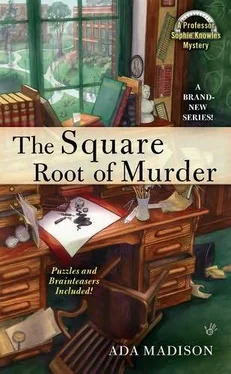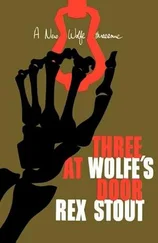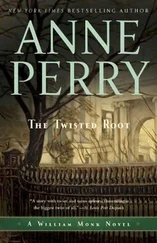Ada Madison - The Square Root of Murder
Здесь есть возможность читать онлайн «Ada Madison - The Square Root of Murder» весь текст электронной книги совершенно бесплатно (целиком полную версию без сокращений). В некоторых случаях можно слушать аудио, скачать через торрент в формате fb2 и присутствует краткое содержание. Жанр: Детектив, на английском языке. Описание произведения, (предисловие) а так же отзывы посетителей доступны на портале библиотеки ЛибКат.
- Название:The Square Root of Murder
- Автор:
- Жанр:
- Год:неизвестен
- ISBN:нет данных
- Рейтинг книги:3 / 5. Голосов: 1
-
Избранное:Добавить в избранное
- Отзывы:
-
Ваша оценка:
- 60
- 1
- 2
- 3
- 4
- 5
The Square Root of Murder: краткое содержание, описание и аннотация
Предлагаем к чтению аннотацию, описание, краткое содержание или предисловие (зависит от того, что написал сам автор книги «The Square Root of Murder»). Если вы не нашли необходимую информацию о книге — напишите в комментариях, мы постараемся отыскать её.
The Square Root of Murder — читать онлайн бесплатно полную книгу (весь текст) целиком
Ниже представлен текст книги, разбитый по страницам. Система сохранения места последней прочитанной страницы, позволяет с удобством читать онлайн бесплатно книгу «The Square Root of Murder», без необходимости каждый раз заново искать на чём Вы остановились. Поставьте закладку, и сможете в любой момент перейти на страницу, на которой закончили чтение.
Интервал:
Закладка:
The complaint had to have come from Keith Appleton, the least social and the biggest snob in the building, if not on campus, if not in the state of Massachusetts.
“Friday was Tesla’s birthday,” I said, with great restraint.
“Whose birthday?”
“The physics department chose the theme for July. They selected Nicola Tesla. He was born on July 10. Well, at midnight on July 9, so it could go either way.”
“Tesla?” the dean asked.
I nodded. “I’m sure you’ve heard of his work in electricity.” I pointed to the lovely Victorian-style lamp on the dean’s desk, as if it were an example of Tesla’s great genius. I thought what a nice jigsaw puzzle the lampshade would make.
I’d deliberately spoken as if I assumed science and mathematics literacy on the part of anyone who deemed herself liberally educated. Or anyone who was a dean at a liberal arts college.
“He was there? At your party?”
I grunted-inaudibly, I hoped-though Dr. Underwood’s severe lack of appreciation for math and science was familiar to me. “No, he, uh, died about seventy years ago.” I fantasized Dean Underwood’s name on my class roster and marked it with a failing grade.
“Of course he did.” Dean Underwood’s pointy nose seemed to take off on its own, now with flaring nostrils, now curling upward toward her frown lines.
I wasn’t proud of this little tactic-putting someone in her place by trying to sound smarter. The truth was that, given the right teacher, anyone could learn mathematics. One of my greatest missions in life was to help students over hurdles that kept them thinking that there was a certain “science brain” or that only a select few had a “knack for math.”
I bristled as I recalled a report from Bruce’s niece, Melanie, that her fourth-grade teacher had promised, “If you behave yourselves this morning, boys and girls, we won’t have to do math this afternoon.”
Grrr . I could have gone on forever on this topic, even with no audience, but the dean was back on track, having straightened out her face.
“The complaint mentioned, in particular, bolts of lightning and fireworks.”
An image of Tesla came to me. Today we would have called him an outside-the-box thinker . One day he’d be experimenting with electromagnetism as a route to time travel, and the next he’d ply himself with enough current to discharge sparks that would make the crackling at our little Franklin party seem hardly worth the trouble.
I called up last Friday in my mind. Almost a week ago. We didn’t have fireworks exactly, but we did create a healthy display of static electricity. On my phone, I had a photo of one student with her long red hair standing out straight from her head. I thought it best not to show the dean.
“The physics majors put together a demonstration of one of Tesla’s experiments. It was spectacular, but harmless, really,” I told the dean.
I spent the next few minutes explaining our custom of monthly parties honoring mathematicians and scientists. I’d been through this description a number of times. Did this dean not listen? Was she too busy being the fashion police? Or did Dean Underwood simply have a short memory for practices she didn’t like?
I gave it my best, final shot. “There’s more to these gatherings than cake and loud noises. The science and math majors research the scientist or mathematician with the birthday of the month and present reports and demonstrations.” I waited for a response. There was none. “I guess this month’s meeting was especially animated,” I added.
I hoped for a compliment on what had been my own inspired idea. I could trace it back to my parents, who’d named me after the eighteenth century French mathematician, Sophie Germain. Sophie and I shared a birthday-April first. We celebrated together every year. How could we not share a love of mathematics?
“Try to keep a measure of decorum, Dr. Knowles,” the dean said finally, sending a loud, agonized breath my way. She stood up and I followed suit.
I wondered who shared a birthday with Dean Underwood. Someone with no sense of humor, I supposed.
On the way to my Ford Fusion, I thought of several brilliant responses I should have made to the dean’s reprimand. For one thing, I wished I’d invited her to the August seventeenth party, for Pierre de Fermat’s birthday. My math majors were preparing a skit about Fermat’s Last Theorem, which he had declared “remarkable,” but never proved. I’d been warned by my students that there was a limerick involved in their interpretation.
I knew I should have been relieved that I hadn’t crossed the line into sarcasm the dean might recognize. After all, my ranking was at stake. Still, it would have been fun to tell her she didn’t have to bring a present for Fermat. He wouldn’t be showing up.
I’d also neglected to mention to the dean that the next party wasn’t that far off. Tomorrow, in fact, the four Franklin Hall departments would be celebrating a brand new doctoral degree. Hal Bartholomew, the students’ favorite physics instructor, had completed all the requirements and would graduate at the end of the year from Massachusetts University.
It was common knowledge that Hal’s thesis had been rejected twice before by MU’s faculty committee. He’d been burdened with an uncooperative crystal to study and had had difficulty acquiring spectral data. He was also balancing his research time with his full teaching load and family life.
As I understood it, delays in collecting data occurred often to those in experimental physics. And anyone who’d ever been in grad school in any field sympathized with the setbacks on the way to an advanced degree.
Anyone except Keith Appleton, that is.
Keith took every opportunity to make a snide remark about Hal’s struggle. I’d never forget his comment when Hal sneezed at Henley’s baccalaureate dinner in June.
“Stay well, Hal,” Keith had said. “After waiting so long and after all those false starts, you don’t want to miss your graduation ceremony.”
To his credit, Hal smiled at the remark and ignored the chance to respond in kind. Gil, his wife, found a way to make a point, however: She put her arm around her husband’s shoulders and said, “Hal will be fine. He has me to take care of him.”
And you, Keith, those in earshot added silently, have no one.
Cheers for Gillian Bartholomew.
As I drove home I amused myself by conjuring ways to get even with Keith for not telling me himself that our Tesla party disrupted his… what? His quiet time? His life? Keith brought out the worst in me.
Then I remembered I’d promised to approach him, nicely, on Rachel’s behalf.
I wished there was a way to banish Keith Appleton from Franklin Hall. And Dean Underwood from the entire Henley campus.
CHAPTER 3
Let it be said: math and science majors know how to party.
To coincide with Hal’s research field, the physics majors had decorated the lounge with a sepia-colored poster featuring Nobelists in physics for the last fifty years, and another with a collage of pioneers in spectroscopy. They’d ordered the largest sheet cake they could afford from the local bakery-I recognized only a few of the equations written in blue icing just under the three-dimensional balloons in multicolored frosting. A nice touch.
My own math majors from my first year of teaching had contributed the gold lamé tablecloth that had graced every Franklin Hall party since. There were always so many drinks, bowls of snacks, and platters of dessert that the accumulated stains from previous parties were easily covered up.
Hal examined a greatly enlarged photograph of himself, looking at least a decade younger and situated on the wall between Albert Einstein and Isaac Newton. “Where did you ever find this?” he asked, scratching his prematurely balding scalp.
Читать дальшеИнтервал:
Закладка:
Похожие книги на «The Square Root of Murder»
Представляем Вашему вниманию похожие книги на «The Square Root of Murder» списком для выбора. Мы отобрали схожую по названию и смыслу литературу в надежде предоставить читателям больше вариантов отыскать новые, интересные, ещё непрочитанные произведения.
Обсуждение, отзывы о книге «The Square Root of Murder» и просто собственные мнения читателей. Оставьте ваши комментарии, напишите, что Вы думаете о произведении, его смысле или главных героях. Укажите что конкретно понравилось, а что нет, и почему Вы так считаете.












